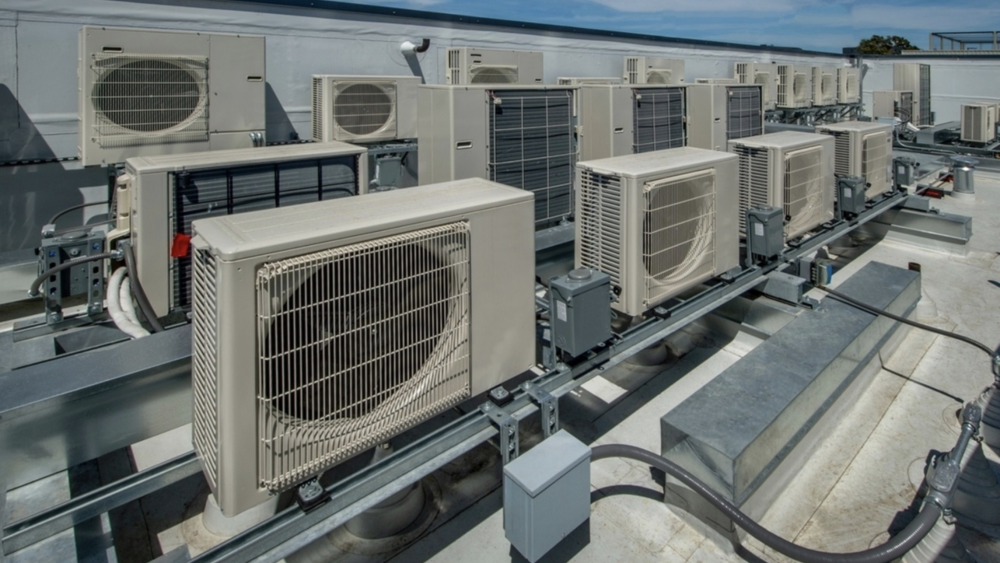In today’s real estate industry, developing and retrofitting buildings to be more sustainable and energy efficient is more important than ever. The urgency to decarbonize is being driven by local, federal, and global commitments to drastically cut energy use and reach net zero emissions.
Systems that heat, cool, and provide electricity to buildings are critically important parts of the decarbonization journey, and they are key to achieving net zero pledges. Among the mechanisms being used to do so, the heat pump has emerged as one of the most popular tools for building owners to slash energy use, cut down on energy costs, and improve indoor environments.
In a new report by ULI’s Randall Lewis Center for Sustainability in Real Estate and ASHRAE, Pumping Up Sustainability, experts break down myths around heat pumps. These experts establish a clear case for why the technology is crucial to reaching sustainability goals and is good for building owners’ collective bottom line. Inspiration for the report came from ULI’s Net Zero Imperative Technical Assistance Panels, a series that continually touches on the importance of electrification as a key to the industry reaching net zero goals. A crucial part of electrifying buildings is installing HVAC systems that do not run on fossil fuels—and here, heat pumps play a significant role.
Heat pump primer
A heat pump is part of an HVAC system that can heat or cool spaces. Heat pumps efficiently move heat from one place to another, depending on where it’s needed in a building. Many run on electricity instead of gas and use a compressor to move heat in the desired direction for thermal comfort. The main difference between a traditional air conditioner and heat pump technology is that a heat pump has a reversing valve, which lets it heat a space as well as cool it. In essence, a heat pump functions like an air conditioner in reverse, by using refrigerant to warm a building instead of keeping it cool.
The two main kinds of heat pumps are air source and ground source. In some cases, heat pumps are paired with traditional heating systems, such as gas furnaces, a combination often referred to as a hybrid heat pump. During the colder months of the year, heat pumps pull heat from the cold outdoor air and transfer it indoors, whereas in warmer months, the systems pull heat out of indoor air to cool building spaces. Because heat pumps, unlike traditional HVAC systems, typically do not burn fossil fuels, these systems are more environmentally friendly and a sustainable alternative for building owners looking to move away from dependence on fossil fuels.
Focusing on heating and cooling in decarbonization efforts is important. According to an article in the World Economic Forum, 15 percent of global carbon emissions comes exclusively from heating and cooling of buildings. To meet net zero targets, buildings eventually need to be powered by renewable energy sources only.
ULI and ASHRAE’s report found that heat pump tech is becoming an increasingly scalable solution on the commercial real estate industry’s path to fully electrifying commercial buildings. By making this transition, owners could slash emissions related to heating and cooling buildings by as much as 20 percent—according to data from McKinsey—which could create healthier and more comfortable environments for building occupants, and pass along energy savings to tenants.
Fact from fiction
Heat pumps are a buzzy subject in the real estate industry, but a clear understanding of what they can and cannot do remains to be reached. Although the technology has existed for quite some time, now that these systems are trending in a big way, myths and outdated information about the limits of heat pumps persist, according to experts. That condition could prevent a wider adoption of these systems.
“A lot of the myths [connect to] legitimate concerns, but there’s always nuance around [them],” says Stet Sanborn, a vice president in the mechanical engineering division at SmithGroup, an architecture and engineering design firm with 20 offices nationwide. Sanborn, who is the mechanical discipline lead for the firm’s San Francisco office, is also a part of ASHRAE’s Task Force for Building Decarbonization.
Among the most common downsides that come up in conversations about heat pumps is the notion that this technology doesn’t work in cold climates. Although that may be true for some heat pumps, Sanborn points to a “whole class” of heat pumps that are specifically designed to work in cold climes. As the report spells out, the highest per capita installation rates of heat pumps are in areas with colder climates.
Another common myth suggests that heat pumps are available only for single-family homes or smaller commercial buildings and don’t work for high-rise or industrial properties. Nonetheless, there are various heat pumps on the market that can work for asset classes across the real estate spectrum and that can be used not only in new construction but also in retrofits of older buildings.
Making the case
Heat pumps have been widely adopted around the world, especially in such places as Japan, where 90 percent of housing stock is multifamily and already has the heat pump installed. In 2022, more heat pumps were sold in China than in any other country. Although the U.S. still lags Europe and other places in heat pump adoption, many owners are seeing the benefits clearly.
Jonathan Arnold, principal at the Kansas City–based firm Arnold Development Group, focuses his firm’s work on sustainable, mixed-use, urban developments. One of the group’s most well-known projects is Second + Delaware, a six-story, 276-unit residential building that is one of the largest Passive House buildings in the world. That project, along with many others Arnold has developed, uses heat pumps.
Even as Arnold experienced the tech’s cost savings and enhanced energy efficiency firsthand, he found that choosing the right kind of heat pump system for a project is key. He urges architects and developers to explore options when considering the technology. “It has the potential of having such an impact financially, for thermal comfort, indoor air quality …. You wouldn’t find developers not caring about finishes in the kitchen or views outside the building, because they matter, they drive value,” Arnold says. “I think the market is waking up to the fact that those things are important, and our industry should pay attention and not just choose the cheapest option possible.”
Not only are heat pumps hugely important on the path to net zero, they bring other benefits to owners and tenants of commercial buildings: air quality and occupant comfort improve, a building’s operational efficiency increases, and the technology can help owners meet regulatory requirements and qualify for such government incentives as rebates and grants.
For professionals in various heat pump–manufacturing, engineering, and HVAC spaces, education on the abilities of heat pumps is a top priority. Reports such as the ULI and ASHRAE study are among the key ways these sectors are doing so, but more work is needed. Still, much progress is being made, and that’s encouraging to professionals at the forefront of sustainability efforts.
“It’s not sexy, but it’s … so fundamental to real estate’s journey to net zero,” says Marta Schantz, co-executive director of ULI’s Randall Lewis Center for Sustainability in Real Estate, about heat pumps. “We’re seeing so many regulations passed, [seeing] policies passed, and seeing investors and tenants seeking out all-electric buildings, and heat pumps [are] truly part of that solution.”







